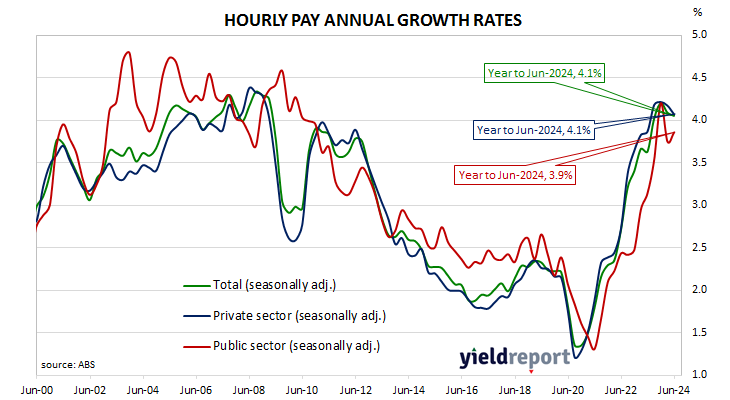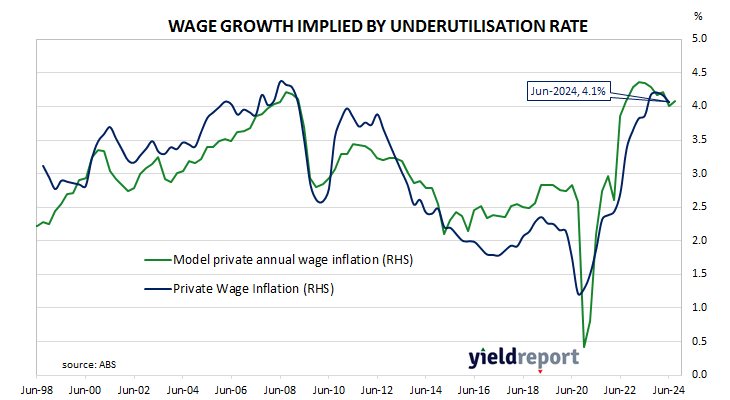Summary: June quarter WPI up 0.8%, slightly below expectations; annual growth rate unchanged at 4.1%; Westpac: wage inflation has moderated in first half of year; ACGB yields fall moderately; rate-cut expectations firm; ANZ: wage growth to continue to trend down slowly, reflects rising spare capacity in labour market, lower inflation, smaller award wage rise this year; private sector wages up 4.1% over year, public sector up 3.9%; June underutilisation rate suggests stable private wage growth in short-term.
After unemployment increased and wage growth slowed during the GFC, a resources investment boom prompted a temporary recovery back to nearly 4% per annum. However, from mid-2013 through to the September quarter of 2016, the pace of wage increases slowed, until mid-2017 when it began to slowly creep upwards. After remaining fairly stable at around 2.2% per annum from September 2018 to March 2020, the growth rate slowed significantly in the June and September quarters of 2020. Growth rates then accelerated over the next three years.
According to the latest Wage Price Index (WPI) figures published by the Australian Bureau of Statistics (ABS), hourly wages excluding bonuses grew by 0.8% in the June quarter. The result was slightly below expectations of a 0.9% increase which also happened to be the March quarter’s rise. On an annual basis, the growth rate remained at 4.1%.
“Wage inflation has moderated in the first half of the year with the six-month annualised pace dipping from 4.7% in December to 3.4% in June,” said Westpac senior economist Justin Smirk.
Domestic Treasury bond yields fell moderately across the curve on the day, largely in line with movements of US Treasury yields on Monday night. By the close of business, the 3-year ACGB yield had lost 4bps to 3.60%, the 10-year yield had shed 5bps to 4.01% while the 20-year yield finished 3bps lower at 4.40%.
Expectations regarding rate cuts in the next twelve months firmed, with a February 2025 rate cut fully priced in. Cash futures contracts implied an average of 4.32% in September, 4.285% in October and 4.20% in November. February 2025 contracts implied 4.03% while July 2025 contracts implied 3.63%, 71bps less than the current cash rate.
“We expect wage growth to continue to trend down slowly, reflecting rising spare capacity in the labour market, lower inflation and a smaller award wage rise this year,” said ANZ senior economist Catherine Birch. “These effects will likely only be partly offset by upcoming wage increases for aged care workers…and the government’s recently announced wage increases for workers in the childcare sector…”
Wages in the private and public sectors grew by 0.7% and 0.9% respectively in the quarter. Over the past 12 months, wages in the private sector increased by 4.1% while public sector wages increased by 3.9%. Annual wage growth in the two sectors had been at 4.2% and 3.8% respectively in the March quarter.
The “underutilisation rate” is simply the sum of the unemployment and underemployment rates as per ABS monthly statistics. It has a good correlation with private wage growth two quarters in the future and thus it is useful as a leading indicator even though differences can open up from time to time. June’s underutilisation rate suggests private wage growth will remain around 4% in the short-term.
Each quarter the ABS surveys around 3,000 private and public enterprises regarding a sample of jobs in each workplace to measure changes in the price of labour across 18,000 jobs. The results are used to construct the Wage Price Index in a manner similar to the construction of the Consumer Price Index (CPI). Changes in the WPI over time provide a measure of changes in wages and salaries, independently of the type or quantity of work.



